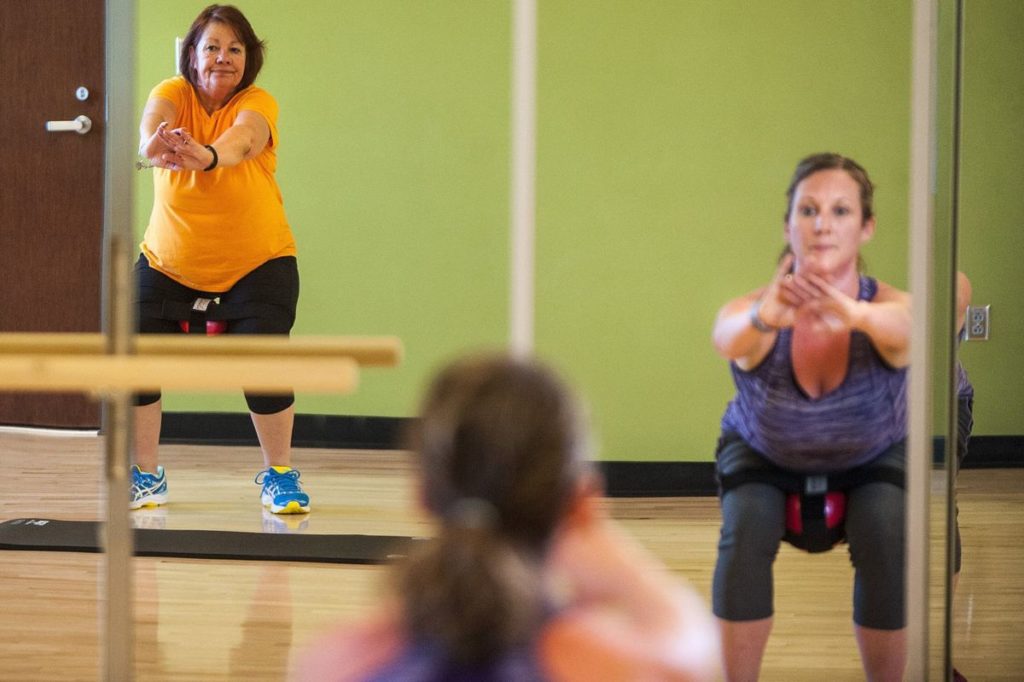Staying healthy: It’s What’s Underneath that Counts
BLOOMINGTON — Sue Mullins and Karen Bennett lunged back and forth, stepped side to side, rotated their hips, bounced up and down and pulled their arms up and back.
Then they did squats, bridges (lying down and raising their hips), knee raises, modified push-ups and modified planks.
But, as they did these and other exercises under the direction of Stephanie Kates, all three women had a small exercise ball between their legs just above the knees. A band wrapped around the ball also was wrapped around the outside of the women’s legs.
Frequently, Kates encouraged Mullins and Bennett to squeeze into the ball or press out against the band.
“Tighten your abdominals,” she said. “Nice job, ladies.”
Mullins and Bennett weren’t taking just any exercise class during the evening of July 6. This was Pelvicore, a class of core strengthening, cardiovascular work, stretching and flexibility exercises using a Pelvicore Pro ball and band. The class is designed to strengthen the muscles of the pelvic floor and the sacroiliac joint.
Pelvic floor muscles hold pelvic organs in place. People notice those muscles the most when they squeeze to keep from urinating.
The sacroiliac joint connects the bone at the bottom of the spine with the pelvis.
The class is for anyone who wants to strengthen their pelvic muscles and core, said Kates, an Advocate BroMenn Medical Center physical therapist specializing in pelvic floor health.
“The pelvic floor is a part of the core but is often forgotten in core strengthening programs and exercises,” said Kates. She teaches the Pelvicore class at the Advocate BroMenn Health & Fitness Center in the Center for Integrated Wellness and also provides specialized physical therapy to strengthen the pelvic floor and lower back at the Advocate BroMenn Outpatient Center.
Kates began teaching Pelvicore a couple months ago and believes its the only Pelvicore class in Central Illinois. While only a few women and men have taken the class so far, Kates knows numbers will increase as more people learn about the class and the specialized physical therapy.
Pelvic floor dysfunction is a weakening of the muscles of the pelvis and the sacroiliac joint. Weakened pelvic floor muscles can lead to incontinence. Weakened sacroiliac joint can lead to low back pain.
While one in three women are affected by weakened pelvic floor muscles, sometimes as a result of pregnancy or childbirth, men also can suffer because of prostate problems, Kates said. Athletic injuries, falls on the tailbone, complications of surgery and being overweight are among other reasons for weakened pelvic floor muscles.
“More people have jobs with prolonged sitting and high stress,” Kates said. “That can cause tightness and weakness in the pelvic floor muscles causing pelvic and back pain.”
Complications include incontinence (lack of control over urination and defecation) or reduced bladder function and bowel movements, and an inability to sit for longer than 15 minutes at a time.
It can affect peoples’ careers, hobbies, household responsibilities, ability to drive, social life and sex life.
“Pelvic floor problems affect a lot of people but are under-diagnosed,” Kates said. Some people are too embarrassed to even tell their doctor.
“It’s a sensitive matter for most people,” Kates said. “Even though it is common, it’s not a normal condition to have. It’s not a natural result of aging and it’s treatable.”
Kegel exercises are the first exercises that people think of to strengthen pelvic floor muscles. This involves identifying the muscles used to stop urination, and then tightening them, holding for five seconds and then relaxing for five seconds four or five times in a row. Mayo Clinic recommends working up to 10 seconds at a time and doing 10 repetitions, three times a day.
Kegels should be done with an empty bladder; don’t do them to stop and resume urine stream, Mayo advises.
Pelvicore takes exercises such as squats, lunges and bridges and adds a ball-and-band combination to work the hips, abdominals and glutes to help the pelvic floor muscles to contract and stabilize, Kates said.
While the class is helpful to address or reduce the risk of pelvic or low back pain, physical therapy is personalized to address specific problems, she said.
While anyone can take the Pelvicore class, physical therapy requires a physician referral.
“Physical therapy has worked well for a lot of chronic muscular problems,” said Dr. Stephen Kindred, medical director of the Advocate BroMenn Health & Fitness Center. “If a pelvic floor problem is musculature in nature, physical therapy would be beneficial.”
Most insurance companies cover a certain number of therapy sessions, Kates said.
Bennett, 63, of Bloomington, was in the class on July 6 for the first time. She wants to strengthen her core.
“I feel great,” she said after class. “It’s harder than it looks. You have to concentrate. It’s very energizing. You use every muscle in your body.”
Mullins, 66, of Normal, has a pelvic floor condition that has been aggravated by stress.
“I knew the class would help me,” said Mullins, who took the class when she lived in northern Illinois and resumed in June after she relocated to Bloomington-Normal.
“It has helped,” Mullins said. “I always have pelvic pain but it’s lessened. There’s been an improvement in my health and well-being.”
Even Kates said that teaching the class has helped her to avoid postpartum incontinence and low-back pain after having a baby eight months ago.
Mullins smiled. “It (the class) makes you feel good about yourself.”

